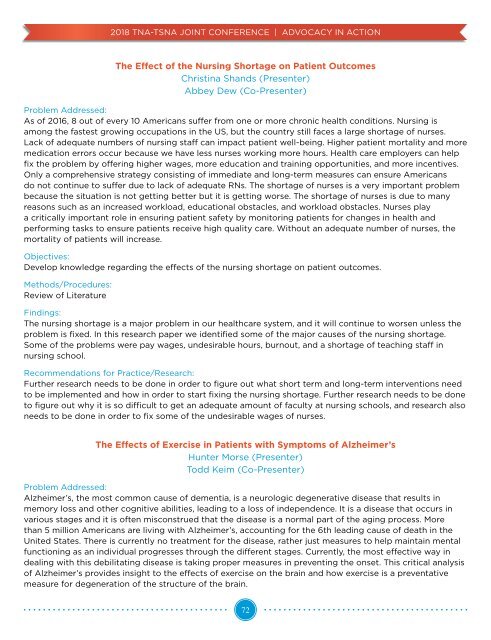2018 TNA and TSNA Joint Annual Conference
Create successful ePaper yourself
Turn your PDF publications into a flip-book with our unique Google optimized e-Paper software.
<strong>2018</strong> <strong>TNA</strong>-<strong>TSNA</strong> JOINT CONFERENCE | ADVOCACY IN ACTION<br />
The Effect of the Nursing Shortage on Patient Outcomes<br />
Christina Sh<strong>and</strong>s (Presenter)<br />
Abbey Dew (Co-Presenter)<br />
Problem Addressed:<br />
As of 2016, 8 out of every 10 Americans suffer from one or more chronic health conditions. Nursing is<br />
among the fastest growing occupations in the US, but the country still faces a large shortage of nurses.<br />
Lack of adequate numbers of nursing staff can impact patient well-being. Higher patient mortality <strong>and</strong> more<br />
medication errors occur because we have less nurses working more hours. Health care employers can help<br />
fix the problem by offering higher wages, more education <strong>and</strong> training opportunities, <strong>and</strong> more incentives.<br />
Only a comprehensive strategy consisting of immediate <strong>and</strong> long-term measures can ensure Americans<br />
do not continue to suffer due to lack of adequate RNs. The shortage of nurses is a very important problem<br />
because the situation is not getting better but it is getting worse. The shortage of nurses is due to many<br />
reasons such as an increased workload, educational obstacles, <strong>and</strong> workload obstacles. Nurses play<br />
a critically important role in ensuring patient safety by monitoring patients for changes in health <strong>and</strong><br />
performing tasks to ensure patients receive high quality care. Without an adequate number of nurses, the<br />
mortality of patients will increase.<br />
Objectives:<br />
Develop knowledge regarding the effects of the nursing shortage on patient outcomes.<br />
Methods/Procedures:<br />
Review of Literature<br />
Findings:<br />
The nursing shortage is a major problem in our healthcare system, <strong>and</strong> it will continue to worsen unless the<br />
problem is fixed. In this research paper we identified some of the major causes of the nursing shortage.<br />
Some of the problems were pay wages, undesirable hours, burnout, <strong>and</strong> a shortage of teaching staff in<br />
nursing school.<br />
Recommendations for Practice/Research:<br />
Further research needs to be done in order to figure out what short term <strong>and</strong> long-term interventions need<br />
to be implemented <strong>and</strong> how in order to start fixing the nursing shortage. Further research needs to be done<br />
to figure out why it is so difficult to get an adequate amount of faculty at nursing schools, <strong>and</strong> research also<br />
needs to be done in order to fix some of the undesirable wages of nurses.<br />
The Effects of Exercise in Patients with Symptoms of Alzheimer’s<br />
Hunter Morse (Presenter)<br />
Todd Keim (Co-Presenter)<br />
Problem Addressed:<br />
Alzheimer’s, the most common cause of dementia, is a neurologic degenerative disease that results in<br />
memory loss <strong>and</strong> other cognitive abilities, leading to a loss of independence. It is a disease that occurs in<br />
various stages <strong>and</strong> it is often misconstrued that the disease is a normal part of the aging process. More<br />
than 5 million Americans are living with Alzheimer’s, accounting for the 6th leading cause of death in the<br />
United States. There is currently no treatment for the disease, rather just measures to help maintain mental<br />
functioning as an individual progresses through the different stages. Currently, the most effective way in<br />
dealing with this debilitating disease is taking proper measures in preventing the onset. This critical analysis<br />
of Alzheimer’s provides insight to the effects of exercise on the brain <strong>and</strong> how exercise is a preventative<br />
measure for degeneration of the structure of the brain.<br />
72

















